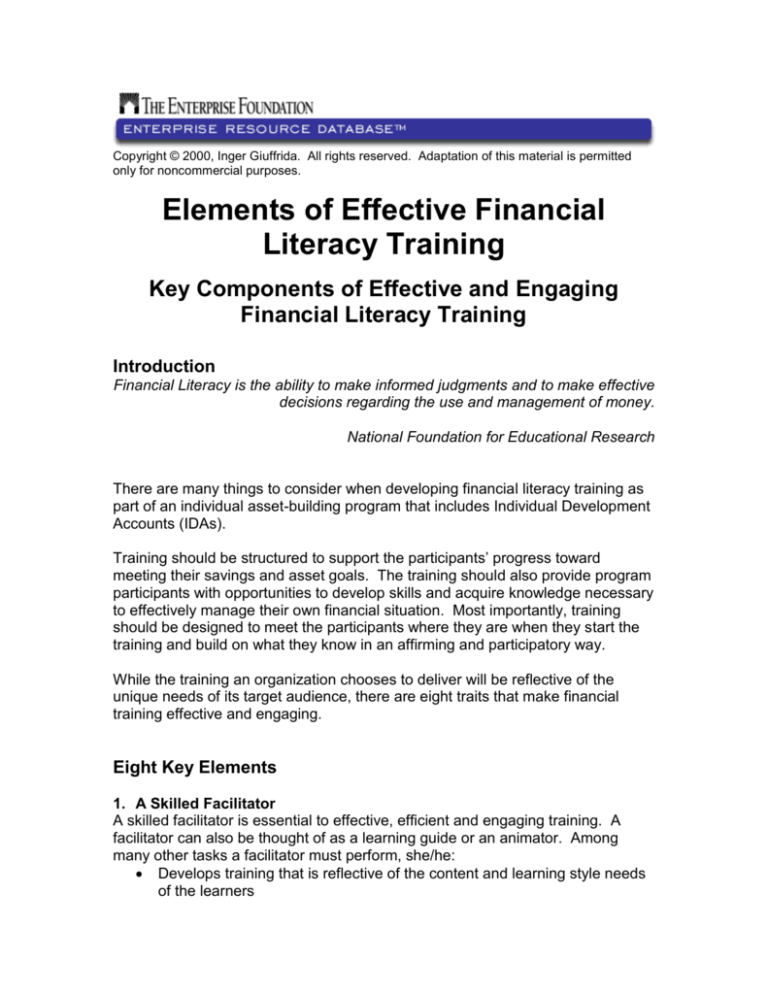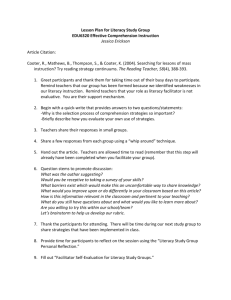
Copyright © 2000, Inger Giuffrida. All rights reserved. Adaptation of this material is permitted
only for noncommercial purposes.
Elements of Effective Financial
Literacy Training
Key Components of Effective and Engaging
Financial Literacy Training
Introduction
Financial Literacy is the ability to make informed judgments and to make effective
decisions regarding the use and management of money.
National Foundation for Educational Research
There are many things to consider when developing financial literacy training as
part of an individual asset-building program that includes Individual Development
Accounts (IDAs).
Training should be structured to support the participants’ progress toward
meeting their savings and asset goals. The training should also provide program
participants with opportunities to develop skills and acquire knowledge necessary
to effectively manage their own financial situation. Most importantly, training
should be designed to meet the participants where they are when they start the
training and build on what they know in an affirming and participatory way.
While the training an organization chooses to deliver will be reflective of the
unique needs of its target audience, there are eight traits that make financial
training effective and engaging.
Eight Key Elements
1. A Skilled Facilitator
A skilled facilitator is essential to effective, efficient and engaging training. A
facilitator can also be thought of as a learning guide or an animator. Among
many other tasks a facilitator must perform, she/he:
Develops training that is reflective of the content and learning style needs
of the learners
Provides the framework for the thinking, doing and discussing
Poses thought provoking questions that lead adult learners toward their
own solutions
Delivers relevant supplemental information
Establishes and maintains the learning climate ensuring the contributions
of all individuals are honored
Provides effective feedback to those engaged in the learning process
Ensures a balance between participants being heard and keeping the
training focused
Searches for common themes among and summarizes participants’
contributions
This role differs from the traditional “teacher” or “trainer” role where the teacher is
seen as:
Possessing all essential information
Filling the “students” minds with knowledge
Talking in the front of the room while the participants passively absorb
information
Having a skilled facilitator at an adult training session is as, if not more, important
than someone with deep content knowledge. Specific content knowledge can be
obtained through expert speakers (volunteer or paid); however, experts most
often do not provide the essential elements (listed above) a facilitator brings to
training to ensure it is learner-focused. It is possible and optimal to find someone
who has both content expertise or experience as well as good facilitation skills.
2. A Well Planned Training Tied to Behavioral (Participant) Objectives With
A Focus on Application
This element is directly related to the principle of adult learning. Adults are very
busy and want specific solutions to their problems. In other words, they expect to
be able to do something or know how to do something new that is useful to
themselves and their families.
Unplanned or poorly planned training is a sign of disrespect and wastes
participants’ time. Effective training design begins with the identification and
development of participant or behavioral objectives. Behavioral objectives state
in specific terms what the session participants will know (cognitive domain), be
able to do (psychomotor domain), or feel about something (affective domain) by
the end of the session.
Behavioral objectives are written descriptions of specific observable behavior or
measurable performance related to the learning. These are written from the
learner’s perspective and do not concern themselves with how the information
will be conveyed (process or teaching objectives). Training content, method and
evaluation flow from the behavioral objectives.
2
3. Content Relevant to Your Audience
The training must be structured to reflect the needs of the audience. This can
and should be determined through needs assessments prior to the development
of training sessions. Even if an organization chooses to use existing curricula, an
assessment of potential participants’ needs is necessary to ensure the training
addresses the issues most pertinent to the audience. Relevant content will keep
the participants engaged in the training and returning session after session.
4. A Training Based On and Reflective of the Principles of Adult Learning
The design and implementation must reflect the principles of adult learning
(covered in the following section). Adults have a great deal of life experience
they bring to training. Tapping into this experience during sessions validates the
adult participants’ experiences and provides a richer learning opportunity for
everyone including the facilitator.
5. A Training that Balances the Diverse Realities of Multiple Learners
While the diversity of the learners is one of the key ingredients for a rich
exchange of ideas and an exciting training, it can be one of the most difficult
aspects of designing and delivering training for adults.
Within your financial literacy training groups, there may be people from different
countries, regions of the U.S., religions, racial or ethnic groups, cultures, stages
in the family life cycle, sexual orientations, etc. as well as a range of ages,
household income levels, and experiences. Every learning style regardless of
which learning style model you subscribe to will be represented, and there may
be people with learning disabilities or phobias in your group. Additionally, there
will be people with different levels of:
Formal education
Experience with financial matters
Literacy and numeracy
Each of the factors listed above in addition to many others will impact the training
design and delivery. Following are some basic tips for working with diverse
audiences:
Develop materials that use inclusive language and illustrations
Cover a range of experiences in the examples you use
Write and deliver materials at appropriate literacy/numeracy levels
Define new terms and use examples to illustrate the meaning of new or
unfamiliar terms
Vary the training method and process regularly within a training session to
appeal to as many learning styles as possible
Note: If you are writing low literacy level materials, ensure the content is age
appropriate. There is often temptation among inexperienced writers to use childlike phrases or subjects when trying to develop materials at low literacy levels.
3
6. An Adult-Oriented and Accessible Location
IDA Money Management and Financial Literacy courses should be held in
locations that are easily accessible to as many participants as possible.
Following are some criteria to keep in mind when choosing a site:
Is the facility oriented toward adults?
Elementary schools, high schools and youth centers are not appropriate
sites for adult classes. Many adults have had prior negative experiences
in these buildings and holding your session in a youth-oriented facility will
make it feel like “school.”
Additionally, the chair and desk sizes will not comfortably accommodate
the wide variety of shapes and sizes of adults.
Is the site accessible for people with disabilities?
Is the site on or near public transportation routes?
Is there childcare on site or nearby?
Is the training space big enough to allow for small group work as well as
full group exercises?
Is the training space pleasant, neat and clean?
The physical space is often an indicator to learners about how you as the
facilitator view them. If the space is neat, clean, well organized and
comfortable, you will convey respect to the participants. If, on the other
hand, the room is dirty and cluttered, it may be taken as a sign of
disrespect.
Also, if your IDA program target market is geographically dispersed, you
may want to hold the training in different locations during the course of a
year.
7. A Training Schedule that is Respectful of the Needs of Your Audience
Finding the ideal time to hold your IDA Money Management and Financial
Literacy Training Course can be difficult. Generally speaking, evenings are best
for adults since most work outside the home or work in the home with their
children during the day. Weekends are also convenient for many participants,
but often people want to focus on their families on Saturday and Sunday.
The best way to determine when you should hold your training is to ask the
potential program participants. Additional scheduling issues or the spacing of the
sessions—once per week, twice per week, once per month—and the time of year
the training should be held.
8. Training that Includes Evaluation
Evaluation is the way to include everyone involved with the training—facilitator,
guest speakers, staff and participants—in measuring the effects of the training.
A well-constructed evaluation will ask for feedback on both content and process
(method). Most importantly, evaluation provides an opportunity for the
participants to contribute in improving their own learning experience as well as
future trainings.
4
Topic Ideas for Financial Literacy Training
The needs assessment you conduct with your IDA and financial literacy program
participants will drive the topics you select for your financial literacy-training
program. If your organization has decided to use a developed curriculum (see
following section for a list of curricula), the outcomes of the needs assessment
will help you select the training best suited for your target audience.
Following is a list of topics commonly included in money management or financial
literacy curricula. Find out from members of your target audience through needs
assessments which topics are most useful to them:
Understanding the Individual Development Account
Setting up, maintaining and using the Individual Development Account
Decision-making or problem solving
Setting priorities
Accessing resources—community resources, financial assistance
resources, credit counseling resources, financial planning resources,
online resources
Identifying values
Setting goals
Identifying barriers or obstacles to achieving goals
Communicating about financial matters with family or household members
Calculating income
Identifying expenses
Identifying and assessing assets and debts
Avoiding money drainers (check cashing operations, rent-to-own stores,
predatory lending)
Reducing debts
Developing strategies to cut expenses (plug spending leaks) and increase
income
Determining ways to save money
Recognizing the range of saving options
Calculating interest and understanding compound interest (Rule of 72)
Using the IDA to build assets
Developing a spending plan to achieve goals
Monitoring plans (tracking progress)
Keeping records
Establishing or repairing credit
Using credit
Ordering and reading a credit report
Financial planning for different stages on the family life cycle or for life
events—getting married or living together, separation or divorce, having
children, personal or family illness or disability, buying a home, retirement,
sending children to college, losing a job, death of a partner or family
member
Using financial institutions—opening accounts
5
Reading statements from financial institutions
Managing a checking account
Using electronic banking services
Getting loans
Standing up for rights as a consumer
Calculating net worth
Recognizing accessible investment options
Managing risk
Determining insurance needs
Reading a paycheck—what is the difference between gross pay and net
pay
Identifying tax obligations
Filing for Earned Income Tax Credit (EITC)
Learning how to avoid tax penalties, underpayment, overpayment
Understanding economic and financial terminology (understanding the
evening news)
Applying economic concepts to personal financial management
Recognizing the interconnectedness of the economy
Developing skills related to specific asset goals—business development,
homeownership, career enhancing education
Organizations with Existing Money Management/Financial
Literacy Curricula Used by IDA Programs
Central Vermont Community Action Council, Inc.
Dollar Sense by Linda Macris and Tim Flacke
National Endowment for Financial Education
This organization has a range of money management and financial literacy
workbooks and curricula available including:
- Habitat for Humanity Homeowners Handbook
- High School Financial Planning Program
- I Can Cope Series (for individuals with cancer and their families and
friends)
Purdue Cooperative Extension
Make Your Money Work
Women’s Self-Employment Project
Money and Assets Money Management Training
University of Illinois Extension
All My Money
6
University of Minnesota Extension Service
Dollar Works – An Education Package to Teach the ABC’s of Economic Literacy
Additionally, Cooperative Extensions from many states offer money management
and economic literacy resources.
7








